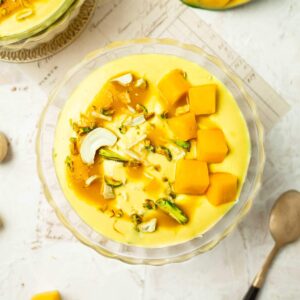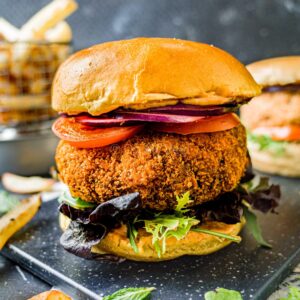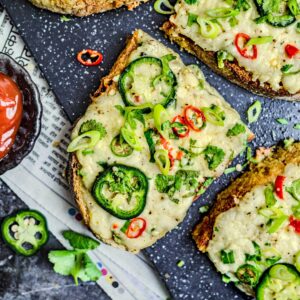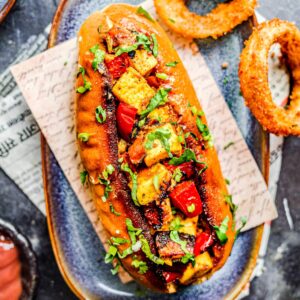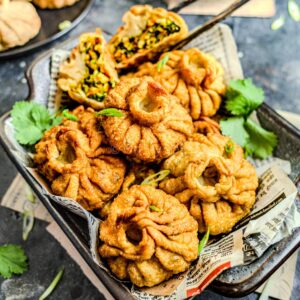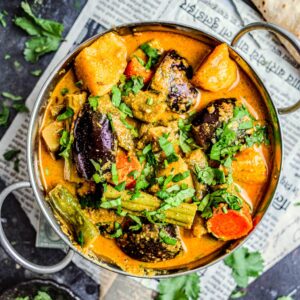Malai Kofta, Indian Restaurant Style
You’re going to fall in love with this malai kofta recipe. It’s probably my version of a “marry me” recipe, because seriously — this dish is so good it’ll win hearts all around! It’s made from crispy potato patties in a rich, creamy, and aromatic sauce that’s almost too good to believe.
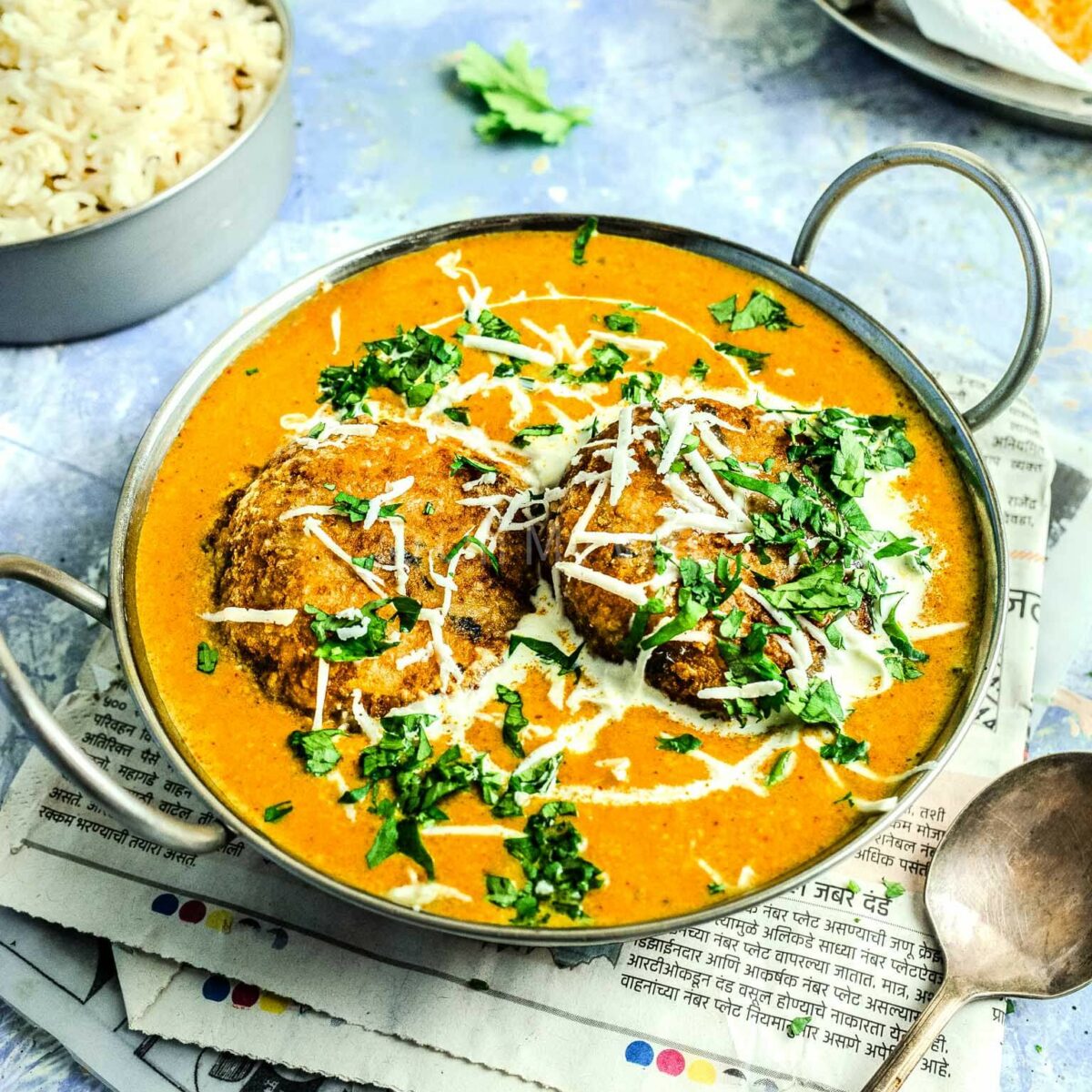
The sauce is unbelievably creamy, enhanced by nutty cashews and rich cream. Fried onions and garlic add sweetness, while the medley of aromatic spices is mouth-wateringly fragrant, adding equal amounts of heat and earthiness. This is no ordinary curry … there’s no tinned tomatoes or coconut milk (sorry — I love it in Thai curry dishes or 15-minute satay tofu!). Just pure, authentic flavours finished with delicate flavours like nutmeg, dried fenugreek, and, of course, warming garam masala.
And these kofta! Although “kofta” usually refers to meat, these are 100% vegetarian. The fritters have the crispiest, golden-brown exterior you can imagine, with an interior of fluffy potatoes mixed with grated mild paneer cheese and fresh herbs. Yum!
Scooping it up with garlic naan is literally what dreams are made of (well, my dreams at least!) It’s the perfect recipe for serving as part of a magnificent Indian feast or thali. Plus, if you celebrate Indian festivals, this malai kofta is perfect for Navratri! So put down the takeaway menu, get your aprons on, and let’s get stuck in.
What is Malai Kofta?
Malai kofta is a rich and creamy North Indian recipe. It features crispy potato and paneer balls cooked in a silky, aromatic sauce full of cream and spices. You’ll struggle to find malai kofta on takeaway menus in the U.K. or the U.S., as it’s an authentic Indian recipe that hasn’t picked up popularity abroad yet! Here in the West, it would be considered a culinary hidden gem — but I love sharing, so please try this restaurant-style recipe!
Where is Malai Kofta From?
Many dishes we eat today originate from Mughlai cuisine (dishes cooked in the Mughal empire), including malai kofta. Biryani, korma, paneer pasanda, kebabs, and even desserts like gulab jamun, seviyan kheer, and falooda are all related to Mughali cuisine.
Since Mughali cuisine mostly influenced North India, you’re more likely to find the dish in North Western or Central Indian states like Punjab or UP (Uttar Pradesh). However, the plate is so delicious and popular with vegetarians (it’s not hard to see why!) that, if you’re lucky, you’ll even find it on some South Indian restaurant menus.
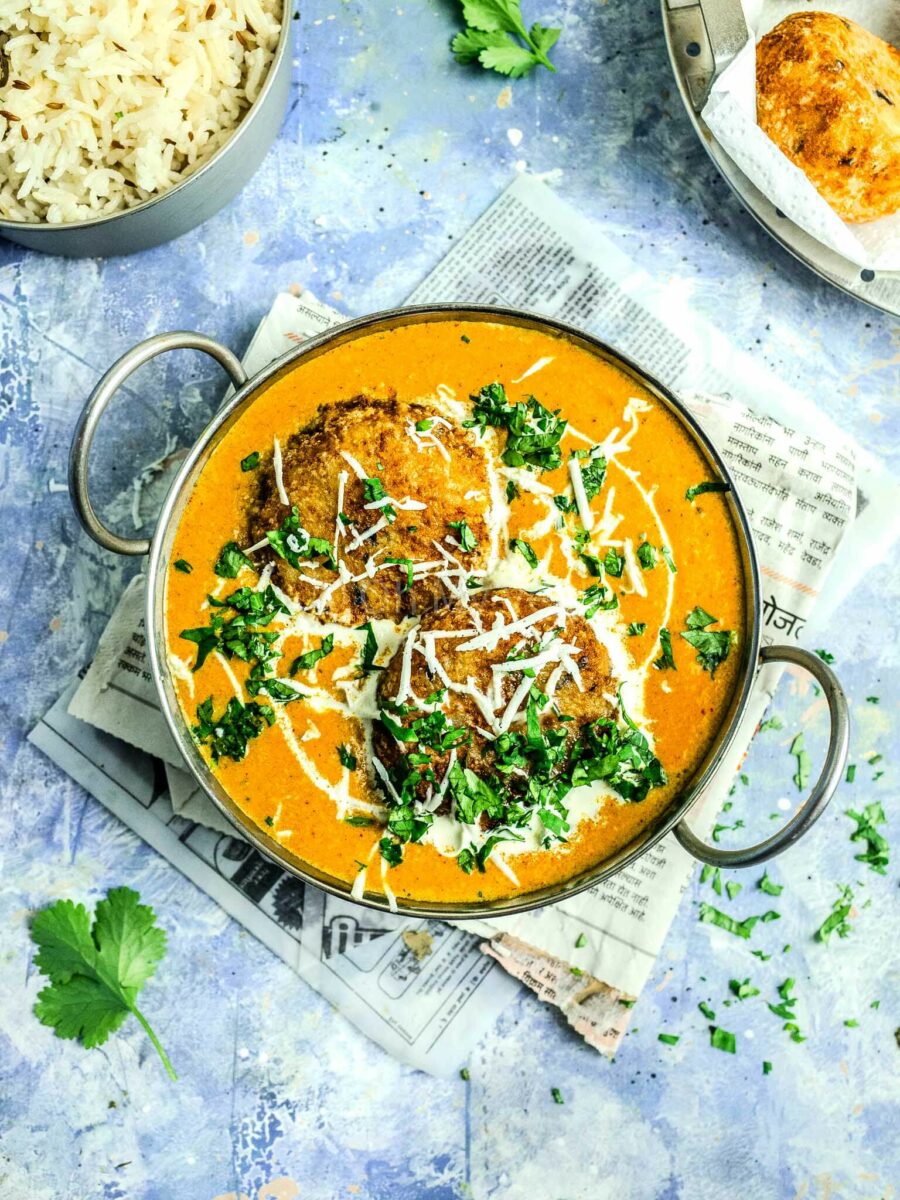
What is Malai Kofta Made Of?
Malai kofta has two components: the gravy (curry sauce) and the kofta (crispy potato and paneer balls). Let’s look at the ingredients you’ll need — this is a great chance to make a shopping list! 🛒
What You’ll Need for the Malai Kofta Sauce:
- White onion builds slight pungency and helps to make that sauce beautifully thick.
- Tomato adds bulk, slight sweetness, and a beautiful orange colour to the curry. I always recommend using fresh; tinned tomatoes are far more intensely flavoured, which, in this case, isn’t desirable.
- Bay leaves contribute warming flavour notes to the malai kofta. It’s crucial to use Indian bay leaves, not European, as they each have a very different flavor profile.
- Black cardamon is intensely smoky, helping to add complexity.
- Cinnamon adds a woody sweetness to the dish. Use “true” cinnamon or Ceylon cinnamon, not cassia bark, which is much spicier.
- Green cardamon is warm and herbal, building phenomenal aromatic layers.
- Cloves are slightly bitter and pungent. In small doses, they add interest to the palette.
- Ginger adds an earthy spiciness.
- Garlic provides buttery richness in every bite.
- Cashews, specifically raw unsalted cashews, make the curry ultra-creamy.
- Water adjusts the consistency of the curry to a silky, restaurant-style malai kofta worth drooling over.
- Butter instead of oil makes this dish restaurant-style. I recommend salted butter for extra flavor.
- Turmeric powder is distinctly earthy, slightly bitter, and with a peppery bite.
- Red chili powder adds heat to this recipe along with a fruity warmth.
- Coriander powder is surprisingly floral with a pleasant lemony aftertaste that layers magnificently with the other spices.
- Nutmeg powder builds on the nutty, sweet, and earthy notes.
- Sugar balances the flavors. Trust the process!
- Double cream is essential to mellow the spices and transform the sauce into a velvety consistency.
- Kasuri methi, also known as dried fenugreek leaves, is deeply savory and slightly bitter with a touch of maple.
What are Kofta Balls Made Of?
I prefer to keep my kofta simple, without too much spicing — it complements that ultra-aromatic creamy sauce rather than competes with it. You’ll only need a few standard pantry items here.
- Potato is the main ingredient in our kofta. Since we’ll be mashing the potato, you want a variety with smooth, dense, and creamy flesh, like Maris Piper, King Edwards, Yukon Golds, or Red Roosters.
- Paneer adds even more creaminess to the kofta, upping the indulgence levels.
- Salt and pepper balances out the seasoning.
- Fresh coriander, also known as “cilantro” in the U.S., is optional but introduces a mild lemony flavor and great freshness.
- Garam masala adds subtle, complex layers of warm spicing.
- Cornflour helps to bind everything together and avoid the kofta falling apart in the oil. I use cornflour (cornstarch in the U.S.), so the recipe is 100% gluten-free! I also save some for dusting the kofta before frying to make them extra crispy.
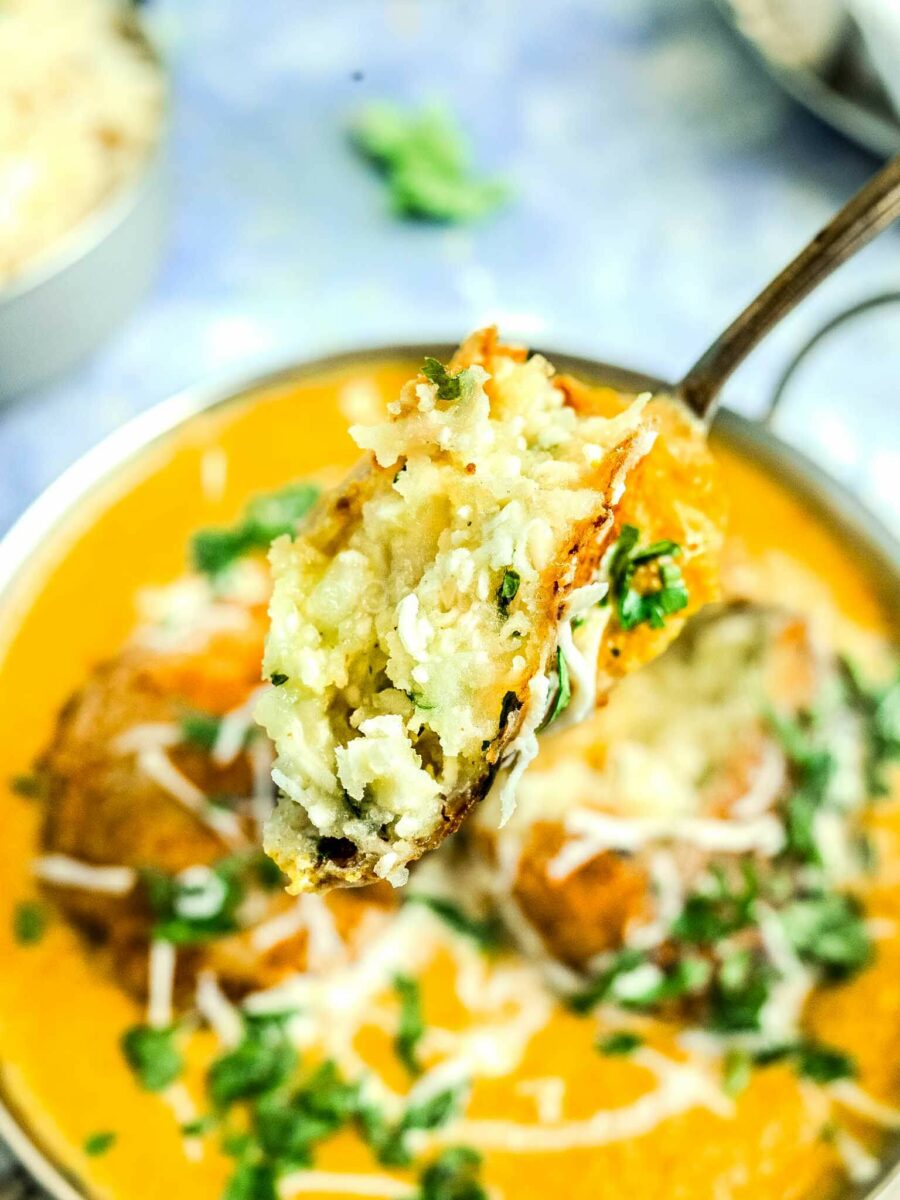
Restaurant-Style Malai Kofta Allergens
I always want to make sure my recipes cater to everyone’s dietary preferences and allergens. That’s no different for this malai kofta recipe! It’s a great one to bring to a party, and if you have family members or friends with additional requirements, it’s no hassle at all to adapt it.
- Malai kofta is 100% gluten-free. I use cornflour to bind the kofta! However, I always recommend checking your spices are pure, as sometimes brands add flour as a thickening agent — grinding your whole spices fresh will avoid this.
- Soy-free and alcohol-free. The restaurant-style malai kofta is great for anyone with allergies or avoiding alcohol for religious/lifestyle reasons.
Now for the adaptations. Instead of leaving you to work things out for yourself, I’ve given clear swaps. Easy peasy!
- Malai kofta isn’t vegan, but it’s easy to adapt. Instead of using paneer in the crispy potato kofta, you’ll want to use grated extra firm tofu. To replace the cream, there are two options: plant-based cream (Elmlea Plant is a good U.K.-based brand), or increasing the amount of homemade cashew cream. It’s as easy as that — just two ingredient swaps!
- Unfortunately, malai kofta isn’t nut-free. I love using cashews in the gravy to achieve a beautifully thick, velvety texture and creamy taste typical of Mughali-style curries. However, you can substitute them for extra dairy or plant-based double (thick) cream.
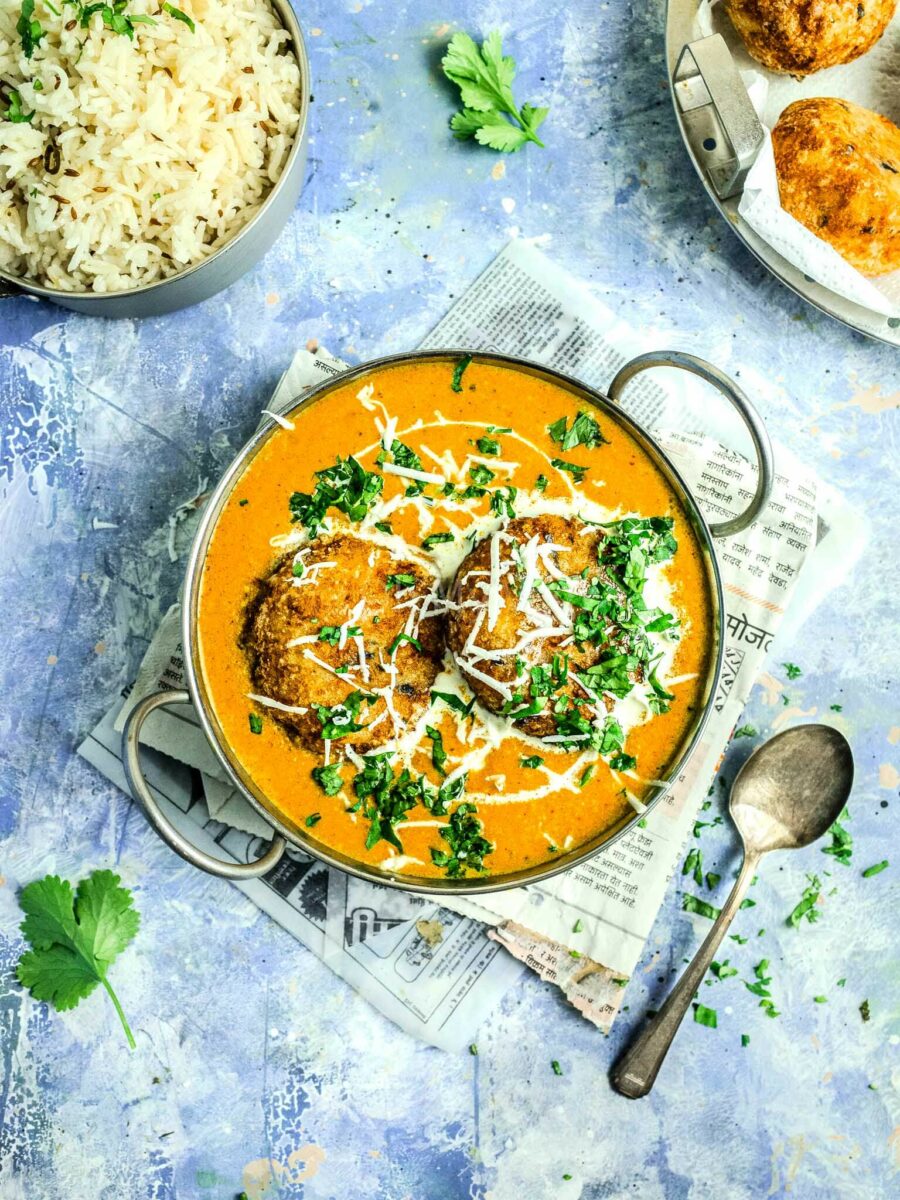
How to Make Malai Kofta
Making malai kofta is surprisingly easy, especially if you’re familiar with cooking Indian dishes. If you’re a beginner to Indian cuisine, the steps can look slightly intimidating — but don’t worry. I recommend allowing yourself some extra time. Moreover, reading through the ingredients list and method a few times to familiarize yourself before cooking is never a bad idea!
- Make the gravy. Heat oil in a large kadai or saucepan and add your aromatic spices. Next, add the onions, ginger, garlic, and tomatoes. Cook until softened slightly, then add the cashews and water. Cover and cook for 15 minutes.
- Make the kofta. Boil potatoes until knife-soft, drain, cool, and then mash. Mix with grated paneer, salt, black pepper, fresh coriander (cilantro), garam masala, and cornflour. Make flattened balls.
- Puree the curry gravy. Once 15 minutes have passed, cool the gravy and blend it until smooth.
- Finish cooking the sauce. Add butter (or ghee) to a large pan over low heat. Add the powdered spices, cook for a few seconds, then add the blended gravy. Season with salt, sugar, double cream, and dried fenugreek leaves.
- Fry the kofta. Heat your oil and carefully fry the kofta until golden brown. Drain off the oil and serve in the curry gravy.
How to Make Malai Kofta without Deep Frying
If you’re scared of deep-frying or merely don’t want to deal with the mess, I’ve got you covered:
- Can you bake malai kofta? Yes! Although I recommend cooking your curry gravy in a saucepan (you can fry off the spices properly then!), you can bake the crispy kofta instead of frying them for a healthier option. Mix all the kofta ingredients as usual, shape them into balls (or discs), and pre-heat the oven to 200 C (392 F). Cook on parchment paper for around 25 minutes, turning halfway, until golden brown.
- Can you air-fry aloo kofta? Yup. Air-frying the kofta is quicker than baking them and healthier than deep-frying them. To make air-fried malai kofta, spray the kofta with cooking spray and arrange them on parchment paper, inside the air-fryer basket. Set the air-fryer to 180 C (356 F) and air-fry for around 5-8 minutes, then turn and cook for another 5-8 minutes, until golden. Spray more oil if necessary.
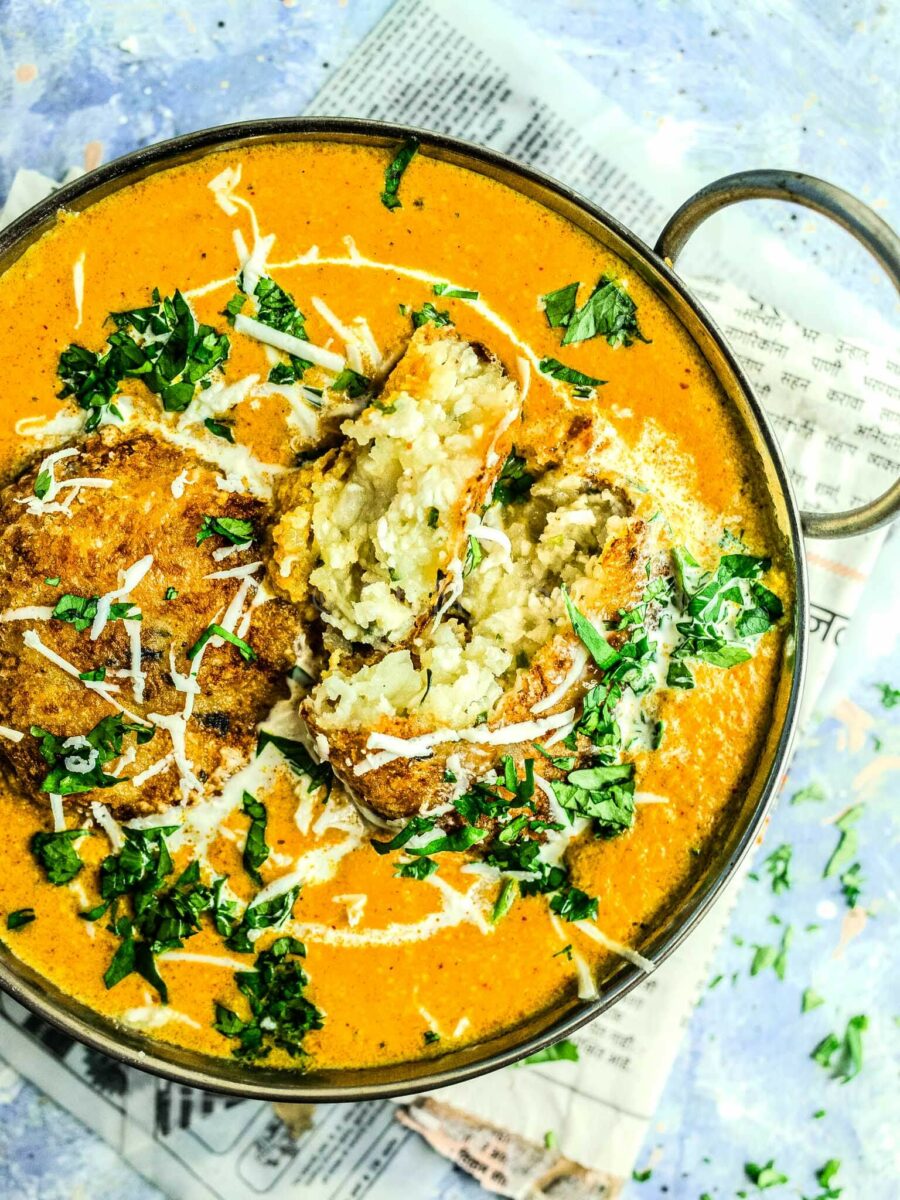
How Do You Eat Malai Kofta?
With great joy! Seriously though — traditionally, Indian people eat with their hand (whichever your dominant hand is). Compared to eating with a knife and a fork, this method produces a greater connection to the food, and I highly suggest it! This is the way to go, especially if you’re opting to enjoy the dish with flatbreads like roti (chapati) or naan.
Eat a piece of the potato-paneer kofta with plenty of the creamy sauce in one bite, rather than eating one and then the other.
What Is Malai Kofta Eaten With?
If you didn’t grow up within the culture (or you did, but never paid attention to the cooking!) dish pairs can be tricky. That’s where I’m here to help! As a general rule of thumb, it’s best to match dishes regionally. I love serving restaurant-style malai kofta with other North Indian classic dishes. Consider Punjabi samosa for starters (or a classic onion bhaji), then hearty chickpeas called chana masala or/and bhindi masala. Finish with a bowl of warm gulab jamun and ice cream …. mmn!
But what about side dishes? It’s really straightforward! Let’s see our options:
- Malai kofta with rice is the easiest choice. Pair it with fragrant long-grain rice like the crowd-favourite, basmati. There’s no need to do anything fancy to the rice, but jeera rice goes down well.
- Garlic and coriander naan with malai kofta is a must for the true restaurant-style experience. The fluffy and soft naan is ideal for mopping up the rich sauce. If you want to be extra fancy, consider cheese-stuffed naan!
- Malai kofta with roti is amazing for a home-style experience. Roti (or chapati) is quite difficult to make, but with practice, you can master it (like me!)
- Flaky paratha with malai kofta is somewhere in between naan and roti. It’s delicious! I always recommend making your own, but alternatively, you can buy them frozen from most supermarkets or Asian stores too.
This Recipe Is:
Malai Kofta, Indian Restaurant Style
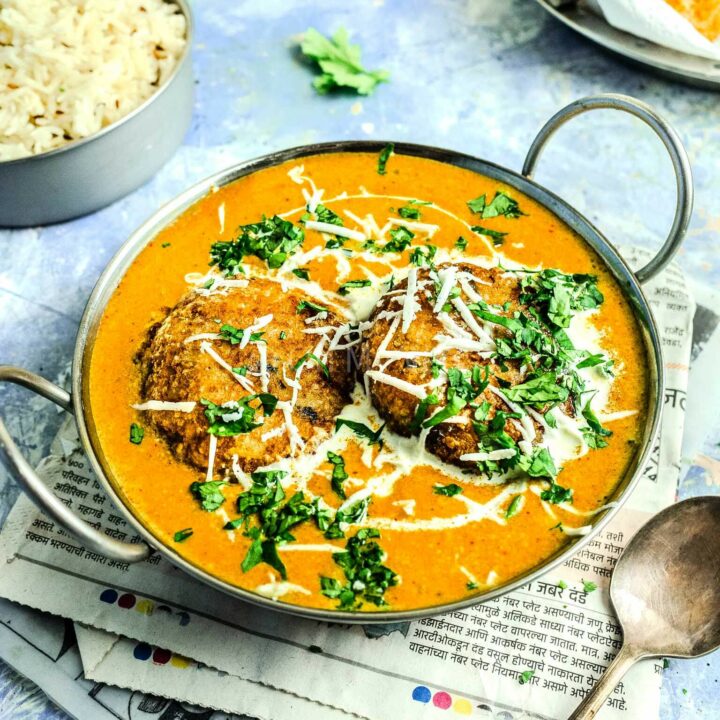
Creamy and richly flavored, this restaurant-style Indian malai kofta recipe boasts crispy potato and paneer balls in an aromatic sauce.
Ingredients
For the Kofta
- 220g Potato, peeled and cut into large pieces
- 120g Paneer, grated
- Sea Salt, to taste
- Freshly Cracked Black Pepper, to taste
- 1 tbsp Freshly Chopped Coriander
- 1/4 tsp Garam Masala
- 1.5 tsp Cornflour
- 1 ltr Neutral Oil (for deep-frying)**
For the Curry
- 1 tbsp Neutral Oil
- 2 Medium Indian Bay Leaves
- 2 Black Cardamon
- 1" Piece True Cinnamon
- 3 Green Cardamon
- 3 Cloves
- 100g White Onion, chopped
- 1" Piece Ginger
- 5 Cloves Garlic
- 280g Tomato (2 and a half large), chopped
- 40g Raw Unsalted Cashews
- 200ml Hot Water
- 20g Butter (or Ghee)
- 1/4 tsp Turmeric Powder
- 1 tsp Red Chili Powder
- 1/2 tsp Coriander Powder
- 1/8 tsp Nutmeg Powder
- 200ml Hot Water
- 1/2 tsp Sugar
- 2 tbsp Double Cream
- 1 tsp Kasuri Methi (Dried Fenugreek Leaves)
Instructions
- Make the gravy. Heat oil in a large kadai or saucepan over medium heat. Add your aromatic spices: bay leaves, black cardamom, true cinnamon, green cardamon, and cloves. Let them cook for 30 seconds - 1 minute until fragrant. Next, add the onions, garlic, and ginger. Sauté for another minute, and add the tomatoes. Cook until lightly softened, then add the cashews and 200ml water. Cover the pan and cook for 15 minutes.
- Meanwhile, make the kofta. Boil the potatoes until knife-soft (roughly 10 minutes), then drain them completely, cool, and mash until smooth. Mix the potato with grated paneer, salt, black pepper, freshly chopped coriander, and a sprinkle of garam masala. Add cornflour and knead into a mass. Don't overwork. Make 6 small balls and gently flatten them*.
- Purée the curry gravy with a hand blender or powerful mixer until smooth. Pass it through a sieve to get that ultra-silky texture.
- Cook the sauce. Heat butter in the large kadai over low heat. Add the powdered spices: turmeric, chili, and coriander powder. Cook them for a few seconds — be careful not to burn the spices or they will become bitter — then add the puréed gravy. Mix well and add 200ml water to adjust the consistency. Simmer on low heat.
- Deep-fry the kofta**. Heat oil in a deep-sided kadai, saucepan, or deep-fat fryer. Once the oil reaches around 180 C (350 F) gently add the kofta.*** Let them fry undisturbed (moving them can break the kofta) until golden brown, then drain.
- Finish the curry with double cream, nutmeg powder, and kasuri methi crushed between your palms. Add the kofta and serve hot with naan or other dishes of your choice.
Notes
* The kofta fry quicker this way, but you can keep them as round balls if you prefer.
** If you would prefer not to deep-fry the kofta, you can also make air-fried or oven-baked malai kofta.
To bake malai kofta: Mix all the kofta ingredients as usual, shape them into balls (or discs), and pre-heat the oven to 200 C (392 F). Cook on parchment paper for around 25 minutes, turning halfway, until golden brown.
To air-fry malai kofta: Spray the kofta with cooking spray and arrange them on parchment paper, inside the air-fryer basket. Set the air-fryer to 180 C (356 F) and air-fry for around 5-8 minutes, then turn and cook for another 5-8 minutes, until golden. Spray more oil if necessary halfway.
*** Don't add the kofta to oil that's too cold, as it can cause them to break. Use a kitchen thermometer or a wooden chopstick test (if the oil bubbles around the tip of a chopstick, it's ready).
Recommended Products
As an Amazon Associate and member of other affiliate programs, I earn from qualifying purchases.
Nutrition Information:
Yield:
4Serving Size:
4Amount Per Serving: Calories: 1392Total Fat: 64gSaturated Fat: 21.6gTrans Fat: 0gCholesterol: 69mgSodium: 0mgCarbohydrates: 200.7gFiber: 40.2gSugar: 24.3gProtein: 35.2g








